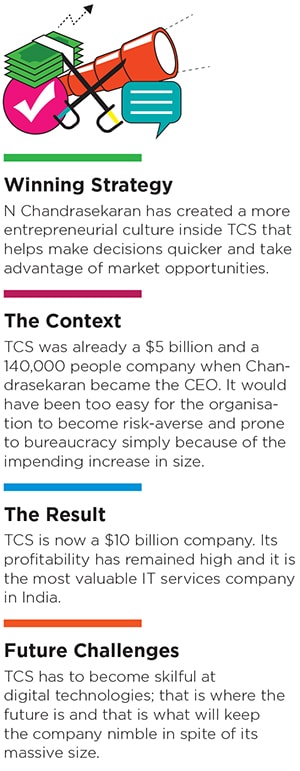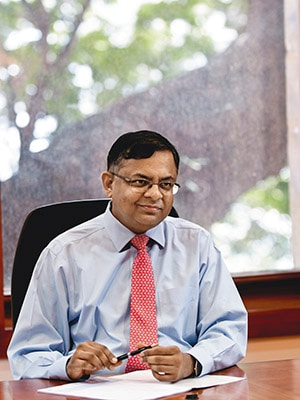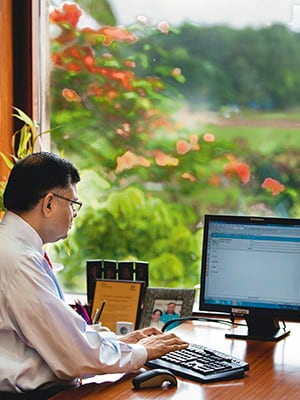
TCS' N Chandrasekaran: Planet of the Apps
N Chandrasekaran throws TCS into the digital deep-end and comes up trumps
Award: Best CEO Private Sector
Name: N Chandrasekaran, CEO and MD, TCS
Age: 49
Why He Won: For being able to balance aggression needed to achieve stretched goals, with conservatism. And for building a solid team of next generation of managers.
Four of the most senior people in TCS are spying on N Chandrasekaran, the CEO. Each mile he runs, each marathon he participates in and the fitness schedule he keeps. Chandra doesn’t mind. He is watching them too. He slides open his iPhone and brings up a nifty-looking application. “We have developed this application called Fit 4 Life,” says Chandrasekaran. It allows TCS employees to form groups of 5, 10 or 15 to keep track of their running, swimming, or even brisk walking. The app helps co-ordinate and also put a bit of peer pressure to make sure everybody remains in the prime of health. “It also helps people bond,” says Chandra. Right now, just a handful of people are using this app, which is in the pilot stage. Eventually, the whole company will get to use it.
Fit 4 Life is just one of the 25 apps that TCS is developing. There is an app that will make the drudgery of filling timesheets—an everyday chore for IT employees—a breeze. Then there is another that will allow people with some commonality—either they stay in the same locality or have gone to the same college—to discover each other. This app mania inside TCS isn’t a fad. “The future is on the smartphone. How can TCS develop the capability to operate in this new world that is based on smartphones, apps and of course young people?” asks Chandra. He has thrown the company into the digital deep-end. There will be some who will flail and scream but most will eventually learn to float and swim.
Chandrasekaran has already started on his next gamechanging project, codename: Vivacious. If successful, it will make TCS ready for the social media, allow easy collaboration across the company, and bridge the gap between youngsters who are very well-versed with the smartphone and the app world. Vivacious will also allow TCS employees to feel more connected to each other and lessen the feeling of a mammoth, cold organisation most large companies exude. On top of all these, it could convert TCS into a mega pilot project that Chandra can showcase to customers for more business. The promise: Develop skills for the company to thrive in the new digital era.
Ask the Question
The Chinese did not say this but the journey to the big question begins with usually one that is much smaller. “How many people do you know?” asks Chandrasekaran. Well...300? Make that 700. After all there are three of us in the room fielding that question. “Has it occurred to you that today you come in contact with many people who you don’t know or will know for a brief moment but all those interactions are valuable?” he persists. And that leads us to the question, a slightly bigger one: “How can an organisation use the power of the not-so-familiar or the mildly strange?” That might sound like a paradox. An organisation is after all a familial unit. There are no strangers.
Now think about TCS. This organisation has 2,50,000 employees across the country. In Mumbai alone, it has 20 offices. Its corporate HQ in the city has more than 300 people, while 19 other offices have about 1,000 people each. Its largest office in Siruseri, near Chennai, has about 25,000 people. It is all very well to group such a dispersed workforce in “small, empowered units” and get them to execute a plan. A bigger challenge is to get the same organisational units to look for new, emerging trends. Any unit is prone to becoming rigid in its way of thinking and a successful unit even more so.
What British Airways Did
Chandrasekaran knows that TCS may be at a juncture where once again he has got to get the organisation to “think big” and not just “execute better”. He saw British Airways take such a step last year. This airline decided to give its cabin crew iPads. Before they boarded the plane, their tablets were loaded with data related to passenger profiles, journey details, seat plans and so on. The response, as recorded by some media outlets, was good. “I’m ahead of myself in knowing where our corporate and high-value customers are sitting, and who needs help,” Bloomberg quoted one BA flight attendant as saying. “They look at you and say ‘have you been on a special course?’”
For Chandra, the BA initiative represented a big shift that’s happening across the industries. “The point is this: By making information available to everyone, you are in effect making everyone an aircraft manager. They can now take decisions because they have information. In effect, you are putting management in the plane,” he said.
That big shift—of information flowing freely within organisation —will be driven by the emerging technologies: Social, mobile, games and so on. These cannot be built in the traditional way. (The traditional way would be to write a project proposal with 2017 as deadline, he says). Instead, he created a group of 100 people, and asked them to build mobile apps.
Chandra knows that the guys in the company who will intuitively understand this are the youngsters, 70 percent of TCS’ employees. He also knows that such technologies and the nature of application development for these platforms—apps—is inherently different from developing core banking software. If banking software is like making a bespoke suit, apps are more like Zara. They need a freshness of approach and a willingness to change the software on the fly, based on customer feedback, of course. So while TCS cannot become like a startup—it is too big for that—it needs all the youngsters on board. It needs their enthusiasm and their way of looking at problems.
“We wanted to enhance our ability to sense and adapt and we wanted to let the liveliness of our GenY workforce loose within the company,” says Hasit Kaji, vice-president, TCS, and the pointman for the project. Kaji had help from Krish Ashok, head of Web Innovation 2.0, TCS. Among certain groups online, Ashok enjoys the status of a minor genius—for giving a ‘Tambrahm’ twist to the Rage Guy meme, and for funny music compositions.
Learning to Collaborate
Ashok believes organisations have three primary challenges for seamless collaboration across an enterprise. The first is people themselves. “People still don’t break out of silos and share. Very often workflows are designed so there is no access to others in an organisation,” he says.
The second challenge is the gulf between youngsters and the old fogeys. “If you introduce something like a Facebook or a LinkedIn the younger employees will adopt it and the older employees will see it as a threat. The older people also want their work and social life to be kept separate,” says Ashok.
The third challenge is that people are wedded to their email. “The email is an ancient technology. It is linear and not at all conducive to collaboration.”
So TCS now has an internal Twitter-like platform. Employees can ‘follow’ anyone inside the company. They post their questions, make suggestions or simply ask for help on the ‘wall’ of that person. When someone answers the query or responds to a help yelp, he accumulates ‘Karma Points’.

The system automatically selects people with a certain number of Karma Points to become moderators of posts. This is actually a coming together of separate platforms inside TCS that are about four years old. One of them was Justask, which was a technology question board, then there was an internal Craiglist-like portal where people trade stuff or exchange information and Ideamax, an innovation marketplace.
This internal social media was quite useful in the years after the financial crisis of 2008. “Very often, you would have guys going on about increments or promotion on these portals. They suddenly had our HR head directly addressing their queries,” says Krish.
Just the satisfaction of having someone senior take their questions directly made them feel better if not totally happy. That has evolved with people now asking for help on something as small as a fixing a macro in an application to seeking help reducing energy consumption in
a data centre.
Now senior management posts challenges on this platform. The best response to a challenge wins an iPad and such stuff.
That Sync-ing Feeling
Chandra has been happy with the results so far. He already has ideas on how the one app that he uses most frequently—Fit 4 life—can be made better. “There is a lot more that one can do with this app, but which we haven’t done. For instance, can we say there must be gender diversity in the virtual groups? Or one could say there must be at least one member from another centre,” Chandra said.
The idea is to open this for all its 250,000 employees. If they have an idea, they convert it into an app, and if an app is good, they get the votes from peers in form of downloads/usage. Eventually, the apps will be the primary way in which the organisation interacts. But the path itself is interesting. In effect, this means tapping the creativity of everyone in the organisation; it means not having to go through the normal circle of planning, budgeting, monitoring; it means bringing an organisation up to the speed of what’s already happening in the world of tech.
The first version of Facebook was written in a dormitory. It took just 18 months for Instagram to get a billion dollar valuation. Twitter grew from a brainstorming session at a podcast company: Work on the project started in March, and the product was launched by July. Project Vivacious is still in its pilot stage. It is yet to be thrown open. “Right now, it’s fuzzy. But it’s better to be fuzzy. If you have clarity, it means you already have an answer,” says Chandra. But there is one answer that is not fuzzy at all.
The most popular ideas are not necessarily the best.
What’s been the most popular idea till date? Do away with offices and to let everyone work from home! Nobody at TCS thinks it is going to be adopted any time soon.
(This story appears in the 30 November, -0001 issue of Forbes India. To visit our Archives, click here.)






